When comparing these two popular chili peppers, the heat difference is substantial enough to impact your cooking decisions. Understanding their precise heat levels helps prevent recipe disasters and ensures you achieve the perfect spice balance in your dishes.
Understanding Pepper Heat Measurement
The Scoville scale, developed by Wilbur Scoville in 1912, measures the concentration of capsaicinoids—the compounds responsible for a pepper's heat. Originally determined through human taste testing, modern laboratories now use high-performance liquid chromatography (HPLC) for precise measurements, though results are still reported in Scoville Heat Units (SHU) for consistency.
Detailed Heat Comparison: Serrano vs Jalapeño
While both peppers belong to the Capsicum annuum species, their heat profiles differ significantly:
| Pepper Type | Scoville Heat Units (SHU) | Relative Heat Level | Typical Culinary Use |
|---|---|---|---|
| Serrano | 10,000-23,000 | Moderate to Hot | Salsas, guacamole, pickled preparations |
| Jalapeño | 2,500-8,000 | Mild to Moderate | Stuffed peppers, nachos, poppers, sauces |
This comparison shows that even the mildest serrano (10,000 SHU) is hotter than the hottest jalapeño (8,000 SHU). The average serrano typically delivers about three times more heat than the average jalapeño.
Factors Affecting Pepper Heat Levels
Several variables influence the actual heat you'll experience when using these peppers:
- Growing conditions: Stressors like inconsistent watering, temperature fluctuations, and soil quality can increase capsaicin production
- Ripeness: Fully ripe red jalapeños and serranos tend to be slightly hotter than their green counterparts
- Plant variety: Different cultivars exist within each pepper type with varying heat levels
- Individual pepper variation: Even on the same plant, heat can differ significantly between peppers
- Preparation method: Removing seeds and white membranes reduces heat substantially
Physical Characteristics and Flavor Profiles
Beyond heat levels, these peppers differ in appearance and flavor:
- Serranos: Typically 1-2.5 inches long, smooth shiny skin, bright green to red when ripe. They have a bright, grassy flavor with citrus notes that complements their intense heat.
- Jalapeños: Usually 2-3.5 inches long, thicker walls, slightly wrinkled skin when mature. They offer a more earthy, vegetal flavor with subtle sweetness, especially when roasted.
Culinary Applications and Substitutions
Understanding the heat difference is crucial for proper substitution in recipes:
- When substituting serranos for jalapeños, use approximately one-third to one-half the amount to maintain similar heat levels
- Jalapeños work better for dishes where you want noticeable heat without overwhelming spice
- Serranos shine in salsas and sauces where their intense heat can distribute evenly
- For stuffed pepper recipes, jalapeños' thicker walls make them more practical
- Serranos' thinner walls make them ideal for quick-pickling applications
Safety Tips for Handling Hot Peppers
Working with hotter peppers like serranos requires precautions:
- Always wear gloves when handling serranos to prevent capsaicin burns on sensitive skin
- Avoid touching your face, especially eyes, while preparing hot peppers
- Wash hands thoroughly with soap and water after handling, even if wearing gloves
- Use separate cutting boards for hot peppers to prevent cross-contamination
- If you experience burning, dairy products (milk, yogurt) help neutralize capsaicin better than water
Regional Availability and Seasonality
Both peppers are widely available in most grocery stores year-round, though:
- Jalapeños are more commonly found in mainstream supermarkets due to their milder profile
- Serranos appear more frequently in Latin American markets and specialty grocery stores
- Peak season for both is late summer through fall, when home gardeners often have surplus
- Freshness significantly impacts heat—wrinkled or soft peppers often indicate reduced potency











 浙公网安备
33010002000092号
浙公网安备
33010002000092号 浙B2-20120091-4
浙B2-20120091-4